| Category | Total Knee Replacement |
Total Knee Replacement
Knee replacement is one of the most successful orthopedic surgeries performed today. Most patients experience reduced or eliminated knee pain, increased ability to move, and an overall improvement in quality of life.
What is knee replacement surgery?
Knee replacement is where portions of the bones that form the knee joint are removed and replaced with artificial implants. It is performed primarily to relieve knee pain and stiffness caused by osteoarthritis.
Most people who get this surgery have advanced knee arthritis, in which the knee cartilage is worn away and the surface of the knee becomes pitted, eroded, and uneven. This causes pain, stiffness, instability, and a change in body alignment. Knee replacement surgery can also help some people who have a weakened knee joint caused by an injury or other condition.
What are the different types of knee replacement surgery?
There are two main types:
Total knee replacement is the more common of these two procedures.
Knee anatomy
To understand a total knee replacement, also known as total condylar knee arthroplasty, you must be familiar with the structure of the knee, a complex joint that consists of three bones:
Strong ligaments connect the powerful muscles of the thigh and calf to the bones around the knee to control knee motion and function. Cartilage (such as the meniscus) and other soft tissues cover and cushion the bones to help them glide together smoothly.
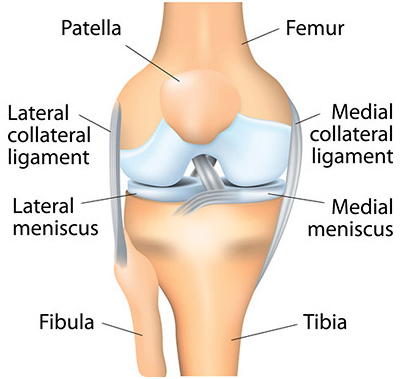
When you bend or straighten your knee, the end of the femur rolls against the end of the tibia, and the patella glides in front of the femur.
When the cartilage that cushions the joint degrades or is worn away completely, the bones rub together and become scraped and rough. This causes inflammation known as osteoarthritis, which results in pain and stiffness that make walking and another movement difficult. The implants used in knee replacement are smooth like the surfaces of a healthy knee.
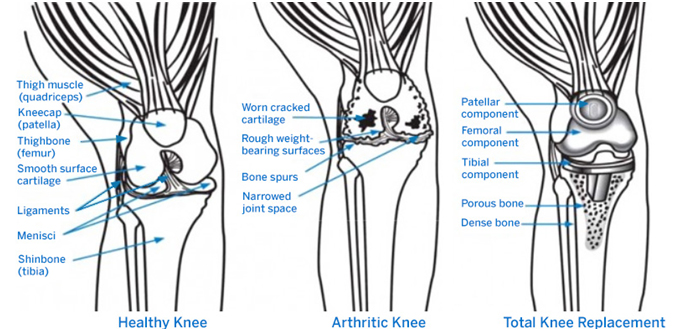
How is a total knee replacement performed?
First, the orthopedic surgeon makes an incision (cut) in the knee and moves the patella (kneecap) to the side. If any bone spurs (small bony growths) are present, as sometimes occurs in osteoarthritis, they will be removed.
Next, the two menisci between the femur and tibia are removed, as are the anterior cruciate ligament (ACL) and, in some cases, the posterior cruciate ligament (PCL). In some types of knee replacement, the PCL is retained.
During the main phase of the operation, the surgeon cuts and removes cartilage and some bone from the upper part of the tibia and lower sections of the femur. The femoral sections removed are two knobby protuberances called the femoral condyles. The tibia and femur are then capped with metal implants to create new surfaces for the joint. The surface of the femoral component mimics the shape of the original femoral condyles. If the kneecap has also degraded, the surface on its underside may also be cut away and replaced with a polyethylene implant.
Finally, the various layers of tissue are repaired with dissolvable sutures and the skin incision is closed with sutures or surgical staples. A bandage will be wrapped around the knee and the patient is being taken to recovery.
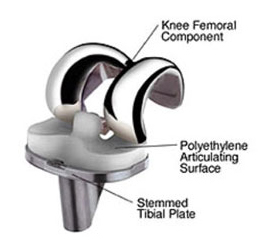
Fixed-bearing knee implant with a polyethylene articulating surface (plastic tray) sandwiched between the metal tibial implant and metal femoral implant.
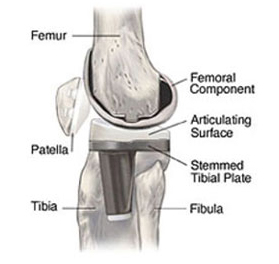
Side-view illustration of a knee with a fixed-bearing knee implant in place.
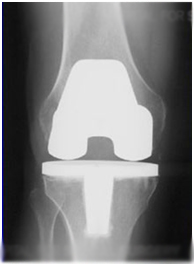
X-ray of a knee after total knee replacement, showing the implanted prosthesis)
What are knee replacement implants made of?
The selection of knee replacement prosthesis design and materials depends on each individual patient. The main implant components are metal – usually titanium or chrome-cobalt alloys. The implants are fixated either with a cement bonding agent or by osseointegration. A porous metal stem extends into the tibia and the patient's natural bone grows into it. A plastic platform or spacer will be inserted between the tibial and femoral implant surfaces. The spacer is made of polyethylene.
Most femoral components are made of metal alloys (cobalt-chromium) or metal-ceramic alloys (oxidized zirconium). The patellar component is plastic (polyethylene). The tibial insert component is also plastic (polyethylene). The tibial tray component can be made of the following materials:
Partial knee replacement overview
A partial knee replacement is also known as unicompartmental knee arthroplasty or unicondylar knee arthroplasty. In this surgery, damaged cartilage and bone are removed and replaced only in one diseased compartment of the knee. This differs from a total knee replacement, in which bone and cartilage from the entire joint are replaced.
Partial knee replacement is suitable for people who experience arthritis only in one compartment (section) of the knee joint, rather than throughout the joint.
Can I avoid or postpone a knee replacement?
The choice on whether to have surgery to address arthritis of the knee joint depends on multiple factors, including:
In cases where the damage from arthritis is minimal, and/or if the patient does not have a very active lifestyle, nonsurgical treatments by being tried, including:
How do I know if I need knee replacement surgery?
You may need surgery if:
How long does a knee replacement last?
Knee replacement implants are expected to function for at least 15 to 20 years in 85% to 90% of patients. However, the implants do not last forever.
After a period of 15 to 20 years, general wear and tear may loosen the implant. Depending on the patient, this may cause no symptoms, or it may cause any of the following:
When these symptoms arise, orthopedic surgeons recommend having knee revision surgery to replace the original implant. Infection, especially, requires immediate revision surgery.
Can knee replacement be done as an outpatient?
Most patients stay in the hospital four to five nights after surgery.
Knee replacement recovery time and recuperation
Total knee replacement surgery generally takes about 30 to 45 minutes
Rehabilitation (physical therapy) will begin within 24 hours of surgery.
After surgery, the nursing staff will position you in bed and help you turn until you are able to move on your own. You may have a pillow between your legs if ordered by your surgeon.
Very soon after surgery, a physical therapist will come to your room to teach you appropriate exercises and review your progress. Gentle exercises to improve your range of motion can help prevent circulation problems as well as strengthen your muscles.
The rehabilitation program will begin as soon as you are medically stable and there are orders to begin postoperative mobility. All patients begin rehabilitation within 24 hours of their surgery. Motivation and participation in your physical therapy program are key to the success of surgery and recovery. The physical therapist will assist in the following activities:
How long is it before I can walk after a knee replacement?
Most patients progress to a straight cane, walker, or crutches within one or two days after surgery. As the days progress, the distance and frequency of walking will increase.
Patients are usually able to drive a car within three to six weeks after surgery and resume most other normal activities by or before six weeks. Complete recuperation and return to full strength and mobility may take three months. However, in most cases, patients are significantly more mobile one month after surgery than they were before they had their knee replacement